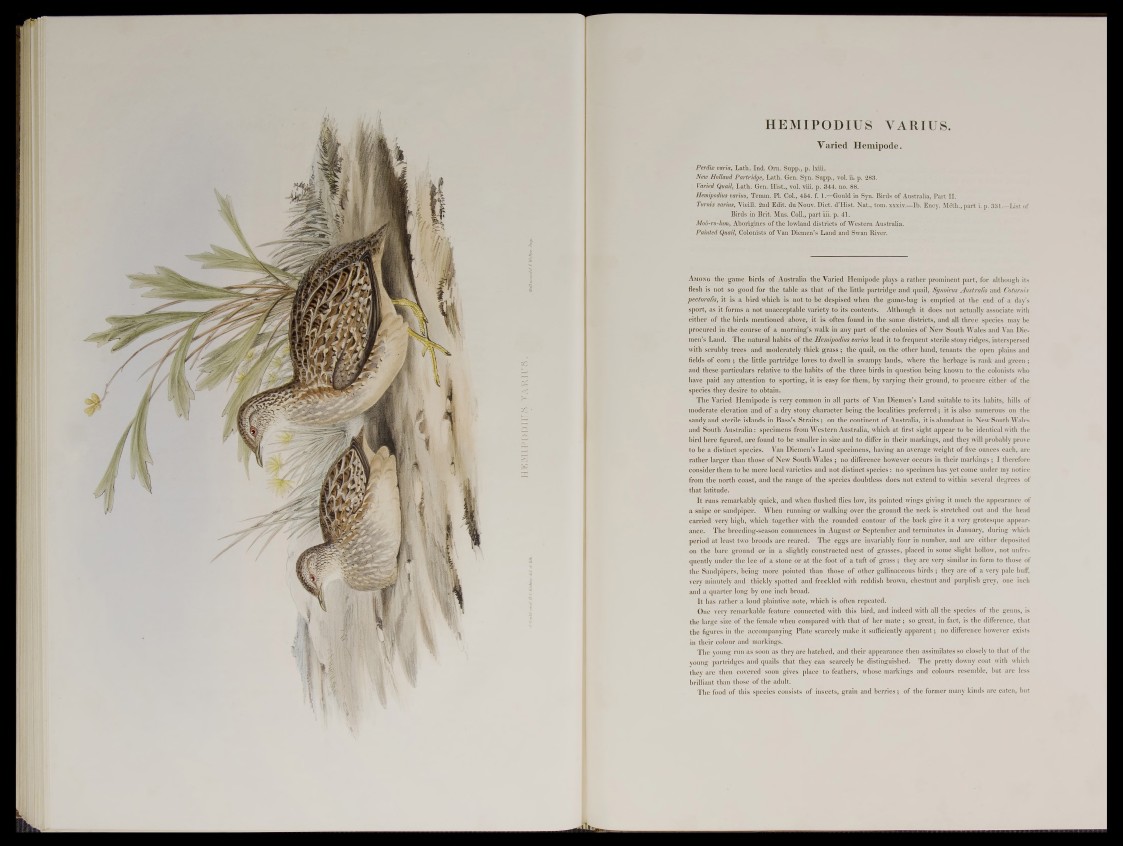
HEMIPODIUS VARIUS
Varied Hemipode.
£erdix varia, Lath. >Ind.-*Qi4fc Sapp
New Holland Partridge, p. 283.
$<0,ed. Quail,* .-; i3 8.
Hemipodius vartimjJ£eram. JP1. f. k ^ n&j ^ M H a of Australia, Part II,
Twnix varvus, Vieill: 2ntTEdit duNsbuy JDicfc. dTIast^ Nat., tom xxxiv —lb. Ency. Meth., part i. p. 331._List of
Moo-ro-ltm, lowland districts of WesternAustfalik \fx’’
Painted Qu^^Colbnists of ‘V an 'Diemen’ s’ River.
A mong the game birds of Australiar-the Varied H^mipbd.e play.s a rather prominent part, for although its
flesh is not so- good fo r^n iltab le as th'at of the little partridge and quail, S y n o icu s A u s tr a lis and C oturnia:
ffggrorfl/iy<,'it^^s^a^birfllmhieMis.-i](^ f 6 ^ ^ ^ ^ p ls ^ d ^m en&the game-bagjs emptied at the 'jmfl/of^a,, day’s
sport, as it forms a ^m;%i^^cepjjible variety to i t ^ ^ m^^^^^lfllmgh^iifejdoes not actually associate with
either of the birds^mentioned • above, it'is .often found ip the same districts, and all three species maybe
procured'ihfthe course» of a morning’s walk in any part df.itheiC0joMb||pfeMc^Sbuth. Wales and Van Diemen’
s Land. The natural habits;of the H em ip o d iu s m r ir n lead' ittofrequ.enf ,stefile/stony ridges', interspersed
with scrubbyftrees'Xandsm oderately thick grass; the*quailvOhpne other hand, tenants the open plains and
fieldsof corn ; the little partridge loves to dwell in swampy lands,’where the herb age is.' rank and gre en;
and these^particulars relative tprthe habits o f the three birds in question being known to the colonists who
have paid any •attention; to,.1 sporting, it is easy for them, by. varying their ground,* to! procure; either of the
specie4:tW^ffi|!l^to obtain: '„
The common in all parts of Van Diemen’s Land suitablcto^ts/babits, hills of
moderate'elevation ^ ^ ^H a ,(d ry stony character being ;£he localities-.preferred; it is also numerous.' on the
sandy and .sterile islands in Bass’s Straits; on the contjnent of Australia, if is abundant in New South Wales
and South^Ausfcralia: specimens from Western Australia, which at first sight appear to be identical with the
bird here ’fig u r e d , ar^fpuhd|tp be smaller in size and to p i^ Sm lfh e ir markings, and they will probably prove
to b^ ^ ^ s i inCT;^bebres~^ V^p Diemen’s Land specimens, having an average weight of five ounces each, are
rather larger than those, of New South Wales ; no difference however occurs in their markings ; I therefore
consider them to be mere local varieties and nct diMindt species: no specimen has yet come under my notice
from the north coast, and the ra n g e ^ ||th e species doubtless does not extend to within several degrees of
that.iaph.flk
It runs remarkably quick, and when flashed flies low&tsmbtbied wings giving it much the appearance of
a sn|j|gc>r sai^piper. When running Qr walking overlljhe^grbjah^^^e neck is stretched opt and the head
carried very high, which together with the rounded e^ontour of the back give i t a very grotesque appearance.
The breeding-season commences in August" or September and1 terminates in January, during which
period at least two broods are reared. eggs are jjqiyariaTdy four in number, and^pr^ either deposited
on the bare ground or in a slightly constructed nest of grasses,, placedrjn spirie slight hollow, not unfre-
quently under th e le e of a stone or at tM ^ ^ t^ ^ ^ ^ ^ |p jf% r a s s /they are y& jflm S jH H um * &. those of
the-Sandpipers, being more pointed than those of other gallinaceous birds; they are ofva very pale buff,
very minutely'and thickly spotted and freckled wtfhTra1®® k brawn, chestniitaud purplifh-: grey, one inch
and a quarter long by one inch broad.
It has ruther a lpud plaintive note, whichd| often repeated:7' • .
One very remarkable feature connected vMi'^^^mird;Jand indeed with all the speciesK^the gennjs, is
the large size of the female when compared ^ ^ S t j a J |f 'b e r m ate; so g re |t,/in>fac t^ lihe difference, that
the figures in the accompanying Plate scarcely m |||||i t sufficiently apparent; no difference however exists
in their cplMp and ipafkiflg$.
The young run as soon as they are hatched, and theiK^fl^arance then assimilates so closest® that of the
young partridges and quails that they can scarcely be distinguished. The pretty downy coat with which
they are then covered soon gives place to feathers, whose markings and-colours resemble, but are less
brilliant than those of the adult.
The food f f t lis species consists of insects, grain anlLberrjesf|'pf the former many kinds are paten, but